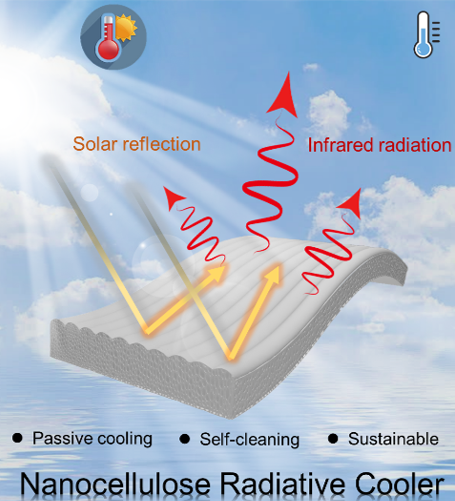A Solution for Global Warming

The 21st century has witnessed a substantial increase in the worldwide need for cooling energy. Significantly, the utilization of air conditioning systems and electric fans contributes to approximately 20% of a building’s total electricity usage.

The scheme for passive cooling is based on nanocellulose radiative cooler. Image Credit: TranSpread.
Investigating environmentally friendly and sustainable cooling technologies offers encouraging potential in addressing global warming and reducing energy consumption.
In a research study featured in the Journal of Bioresources and Bioproducts by KeAi, a group of Chinese scientists unveiled a scalable radiative cooling film based on nanocellulose aerogel resistant to dust.
Due to its high emissivity within the atmospheric transparency window (λ≈ 8-13 µm), cellulose has been identified as a viable candidate for radiative cooling.
Chenyang Cai, Study First Author and Associate Professor, College of Materials Science and Engineering, Nanjing Forestry University
Cai added, “Nevertheless, conventional cellulose-based cooling systems often exhibit inadequate solar reflectivity and susceptibility to external dust contamination, leading to diminished daytime cooling efficiency.”
To achieve that goal, the researchers have created a sustainable passive cooling material called nanocellulose aerogel film. This material possesses strong capabilities for solar reflection and infrared emissivity, rendering it exceptionally efficient for passive cooling in the summertime.
The scalability of the nanocellulose aerogel film is achieved through freeze-drying and hot-pressing techniques. This pioneering cellulosic cooling solution can deliver a sub-ambient temperature reduction of 6.9 °C under direct sunlight in hot conditions while also exhibiting dust-repellent properties.
Chenyang Cai, Study First Author and Associate Professor, College of Materials Science and Engineering, Nanjing Forestry University
These sustainable passive cooling materials, characterized by advantageous optical properties and hydrophobicity, offer valuable insights into the advancement of next-generation thermal control materials, thereby supporting the achievement of carbon neutrality.
It is worth mentioning that most daytime radiative coolers employ petroleum and heavy metal-based materials, leading to secondary air pollution. Furthermore, their cooling performance in hot summers required improvement.
We hope our study opens up new avenues for scientists to further explore cellulose-based materials for thermal regulation, addressing the issue of high energy consumption.
Chenyang Cai, Study First Author and Associate Professor, College of Materials Science and Engineering, Nanjing Forestry University
Journal Reference:
Cai, C., et al. (2023). Large scalable, ultrathin and self-cleaning cellulose aerogel film for daytime radiative cooling. Journal of Bioresources and Bioproducts. doi.org/10.1016/j.jobab.2023.06.004.
Source:
link




